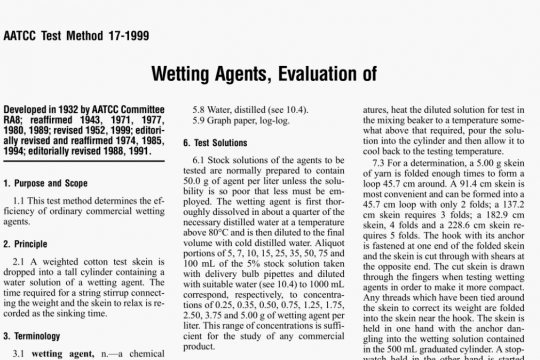AATCC 106 pdf free download
AATCC 106 pdf free download.Colorfastness to Water: Sea.
1. Purpose and Scope
1.1 This test method is designed to measure the resistance to sea water of dyed. printed, or otherwise colored textile yarns and fabrics of all kinds.
1.2 Artificial sea water is used in this test because natural sea water is variable in composition, and is often difficult to obtain.
2. Principle
2.1 The specimen. backed by muhifiber test fabric, is immersed in artificial sea water under specified conditions of temperature and time, and then placed between glass or plastic plates under specified conditions of pressure, temperature and time. The change in color of the specimen and the staining of the attached multifiber test fabric are observed.
3. Terminology
3.1 colorfastness, n.—the resistance of a material to change in any of its color characteristics, to transfer of its colorant(s) to adjacent materials or both, as a result of the exposure of the material to any environment that might be encountered during the processing, testing, storage or use of the material.
4. Safety Precautions
NOTE: These safety precautions are for information purposes only. The precautions are ancillary to the testing procedures and are not intended to be all inclusive. It is the user’s responsibility to use safe and proper techniques in handling materials in this test method. Manufacturers MUST be consulted for specific details such as material safety data sheets and other manufacturer’s recommendations. All OSIIA standards and rules must also be consulted and followed.
4.1 Good laboratory practices should be followed. Wear safety glasses in all laboratory areas.
4.2 All chemicals should be handled with care.
4.4 Observe padder safety. Ensure adequate guard at the nip point. Normal safeguards on pad should not be removed.
5. Apparatus and Materials
5.1 AATCC Perspiration Tester, Perspirometer or equivalent device (plastic or glass plates are available with the equipment) (see 12.1 and 12.2).
5.2 Drying oven—convection.
5.3 Multifiber test fabric No. 1 or No.
10 (see 12.1).
5.4 AATCC Chromatic Transference Scale (see 12.1).
5.5 AATCC Gray Scale for Color Change and Gray Scale for Staining (see
12.1).
5.6 Wringer (see 12.3).
6. Test Solution (Artificial Sea Water)
6.1 Per liter:
Sodium chloride (NaCI), tech. 30 g
Magnesium chloride (MgC12), anhyd, 5g
Distilled water to make 1000 mL solution
7. Test Specimens
7.1 Colored specimens 60 x 60 mm ± 2 mm (2.25 x 2.25 in.) backed with multifiber test fabric (see 12.1).
8. Procedure
8.1 Immerse the test specimen in the test solution at room temperature with occasional agitation to ensure thorough wetting out (approximately 15 mm generally required for average fabrics) (see
12.4).
8.2 Remove the test specimen from the test solution and only pass between squeeze rolls (wringer) to remove excess liquor when the wet weight of the test specimen is more than 3 times its dry weight. Whenever possible, the wet weight should be 2.5-3.0 times the dry weight.
8.3 Place the test specimen between glass or plastic plates and insert in the specimen unit of the perspiration tester. Adjust the perspiration tester to produce a pressure of 4.5 kg (10.0 Ib) on the test specimen (see 12.2).
8.4 Heat the loaded specimen unit in an oven at 38 ± 1°C (100 ± 2°F) for 18 h. Remove specimen from unit and complete drying by hanging in air at room temperature. Do not press dry.AATCC 106 pdf download.




